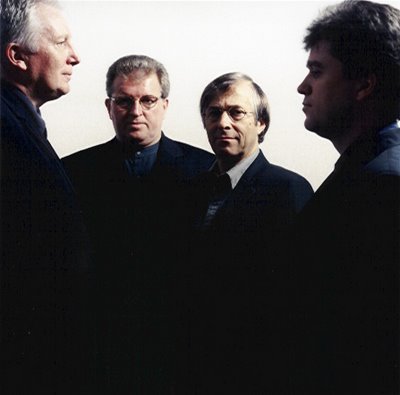 Hilliard Ensemble (L to R, Gordon Jones, David James, Rogers Covey-Crump, Steven Harrold), photo by Friedrun Reinhold |
This program was anchored on the four-part setting of the Ordinary and most of the Propers of the Mass for the Dead by Orlando Lassus (1532-1594). A simple and somber setting, it consists largely of homophonic chords that bloom and close back up gently and slowly. It strikes the ear as fairly utilitarian, requiring only about thirty minutes to perform -- the Hosanna refrain of the Sanctus, for example, is only a few bars of rather plain chords. It did not seem to inspire the singers to great expressive heights, mostly revealing some of the voices' weakness, either from the strain of touring or illness. It was a far cry from the group's classic recording from the 1990s (now reissued by ECM), where the Requiem was paired with the composer's daringly chromatic prophecies of the sibyls.
Lassus, Missa pro defunctis / Prophetiae Sibyllarum, Hilliard Ensemble Palestrina and Victoria, Officium Defunctorum, Hilliard Ensemble |
To make a program that lasted just over an hour with no intermission, the Lassus was augmented with a few of Palestrina's settings of responsory texts from the Office of the Dead (also recorded by the group in the 1990s and reissued by ECM). Strangely, the comparison showed Palestrina, a composer who is often held up as a model of balance and restraint, as the more daring and emotional. Where Lassus had eschewed any kind of text painting, not using a starkly descending bass line to describe the "profundo lacu" of the Offertory, for example, Palestrina provided many such expressive musical images, such as the upward-arcing arrows of the vocal lines at the word "Sagittae" in Ad dominum cum tribularer. Even Palestrina's harmonic vocabulary was more extensive and unusual, especially the unexpected progressions in the exquisite closing Kyrie section of Libera me domine.
Anne Midgette, The Four Renaissance Men of the Hilliard Ensemble (Washington Post, February 14) |
The next major event at the Kennedy Center Terrace Theater is tomorrow afternoon's Beethoven marathon by cellist David Hardy and pianist Lambert Orkis (February 15, 2 pm and 4:30 pm).
No comments:
Post a Comment